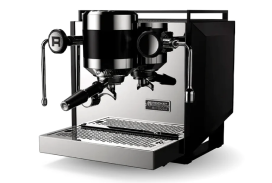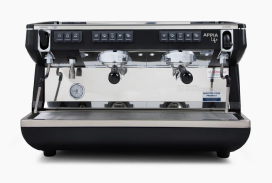SHOP BY machine TYPE
SHOP BY boiler type
Explore Our Handpicked Coffee Equipment -
for Home | for Commercial
Get Monthly Offers & Discounts - 5% off Now
Sign Me Up
SHOP BY machine TYPE
SHOP BY boiler type

Espresso machines
SHOP BY machine TYPE
SHOP BY boiler type
Renewed Machines
SHOP BY machine TYPE
SHOP BY boiler type
Accessories
Best Bundles
Espresso machines
Accessories
Best Bundles
When choosing an espresso coffee machine with milk steamer, capacity is one of the most important factors. A small single-group machine may be perfect for a boutique café or office lounge, but it will struggle in a high-volume environment where multiple drinks need to be prepared at once.
Commercial models typically come in one, two, or three-group configurations, each designed for a specific output range. For example:
Selecting the right capacity ensures your machine can handle peak service without long queues or compromised drink quality.
For any café serving cappuccinos, lattes, or flat whites, steam power is just as critical as espresso extraction. The best espresso machines with milk steamers provide strong, consistent steam pressure, which helps baristas create silky microfoam quickly.
Key factors to consider include:
Strong steam output not only improves drink quality but also speeds up service during busy rush hours.
A true espresso coffee machine with milk steamer is a long-term investment. Machines with durable brass groups, stainless steel boilers, and commercial-grade steam valves last significantly longer than entry-level units with lighter construction.
Important details to evaluate:
By investing in robust build quality, you ensure the machine remains reliable even after years of daily use.
Not every business needs a brand-new unit. At Pro Coffee Gear, we offer expertly renewed machines that go through our Pro Renewal process. This includes:
This process ensures that every espresso coffee machine with milk steamer we sell—new or renewed—delivers dependable performance right from installation.
To protect your investment, all our renewed machines come with a warranty. Beyond that, Pro Coffee Gear provides lifetime customer support, so you’re never left without guidance or solutions.
This means:
When you purchase from us, you gain more than a machine—you gain a partner dedicated to your coffee program’s success.
What advantages does an espresso machine with a milk steamer offer over a standalone steamer?
An integrated system allows baristas to pull shots and steam milk simultaneously, streamlining workflow and ensuring drinks are served hotter and faster. It also saves counter space compared to having separate units.
What capacity espresso coffee machine with milk steamer works best for a high-volume café?
For cafés serving 150–300 drinks per day, a two-group commercial machine is ideal. For very busy locations, a three-group unit with dual steam wands ensures multiple staff can work at once.
How can I check if a milk steamer is strong enough for consistent microfoam?
Check the boiler size (larger steam boilers produce stronger, sustained power), recovery time between steaming, and whether the machine is rated for commercial use. A quick test is to see how long it takes to steam a 12oz pitcher—under 20 seconds is a good benchmark.
Is a dual-boiler machine essential for both espresso and milk steaming?
Not always. Heat-exchanger machines allow simultaneous brewing and steaming, but dual-boiler machines provide greater temperature stability and are preferred in high-volume cafés.
What does the Pro Renewal process involve for the steaming components?
We inspect and replace steam valves, test steam wand output, descale the steam boiler, and ensure consistent pressure. This guarantees the machine is ready for commercial service.
Usually ships within 1-2 business days
CAMEO C'2M
Eversys
Usually ships within 2-6 weeks
Usually ships within 2-4 business days
Usually ships within 2-6 weeks
S20 Fresh Brew
La Cimbali
Usually ships within 2-4 business days
S15 CS10
La Cimbali
Usually ships within 2-4 business days
Usually ships within 2-4 business days
S60 CP10
La Cimbali
Usually ships within 12 weeks
When choosing an espresso coffee machine with milk steamer, capacity is one of the most important factors. A small single-group machine may be perfect for a boutique café or office lounge, but it will struggle in a high-volume environment where multiple drinks need to be prepared at once.
Commercial models typically come in one, two, or three-group configurations, each designed for a specific output range. For example:
Selecting the right capacity ensures your machine can handle peak service without long queues or compromised drink quality.
For any café serving cappuccinos, lattes, or flat whites, steam power is just as critical as espresso extraction. The best espresso machines with milk steamers provide strong, consistent steam pressure, which helps baristas create silky microfoam quickly.
Key factors to consider include:
Strong steam output not only improves drink quality but also speeds up service during busy rush hours.
A true espresso coffee machine with milk steamer is a long-term investment. Machines with durable brass groups, stainless steel boilers, and commercial-grade steam valves last significantly longer than entry-level units with lighter construction.
Important details to evaluate:
By investing in robust build quality, you ensure the machine remains reliable even after years of daily use.
Not every business needs a brand-new unit. At Pro Coffee Gear, we offer expertly renewed machines that go through our Pro Renewal process. This includes:
This process ensures that every espresso coffee machine with milk steamer we sell—new or renewed—delivers dependable performance right from installation.
To protect your investment, all our renewed machines come with a warranty. Beyond that, Pro Coffee Gear provides lifetime customer support, so you’re never left without guidance or solutions.
This means:
When you purchase from us, you gain more than a machine—you gain a partner dedicated to your coffee program’s success.
What advantages does an espresso machine with a milk steamer offer over a standalone steamer?
An integrated system allows baristas to pull shots and steam milk simultaneously, streamlining workflow and ensuring drinks are served hotter and faster. It also saves counter space compared to having separate units.
What capacity espresso coffee machine with milk steamer works best for a high-volume café?
For cafés serving 150–300 drinks per day, a two-group commercial machine is ideal. For very busy locations, a three-group unit with dual steam wands ensures multiple staff can work at once.
How can I check if a milk steamer is strong enough for consistent microfoam?
Check the boiler size (larger steam boilers produce stronger, sustained power), recovery time between steaming, and whether the machine is rated for commercial use. A quick test is to see how long it takes to steam a 12oz pitcher—under 20 seconds is a good benchmark.
Is a dual-boiler machine essential for both espresso and milk steaming?
Not always. Heat-exchanger machines allow simultaneous brewing and steaming, but dual-boiler machines provide greater temperature stability and are preferred in high-volume cafés.
What does the Pro Renewal process involve for the steaming components?
We inspect and replace steam valves, test steam wand output, descale the steam boiler, and ensure consistent pressure. This guarantees the machine is ready for commercial service.
Sign up and get 5% off first order
Sign up for our newsletter to keep up with new products, events and 5% off your first order!









